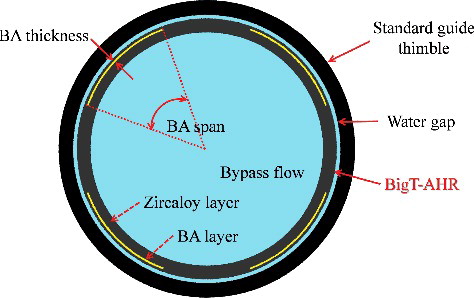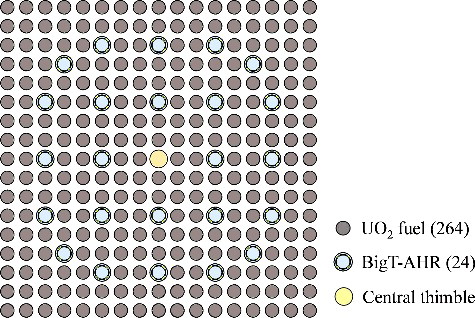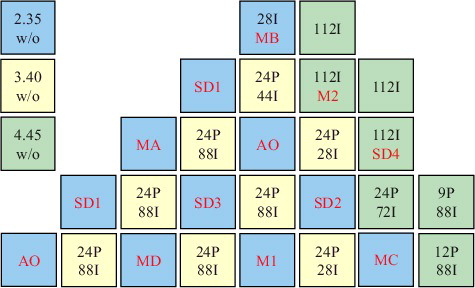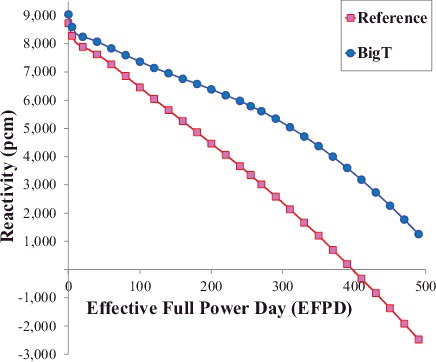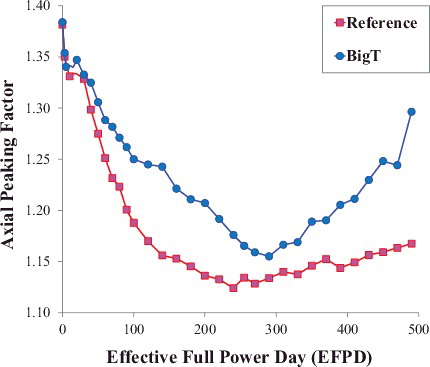ABSTRACT
This paper is a companion to its immediate predecessor in the “Burnable absorber-integrated Guide Thimble” (BigT) series. It aims to demonstrate potential applications of the BigT concepts in a three-dimensional (3D) commercial pressurized water reactor core, which is based on the AP1000 first core design. The study specifically compares neutronic characteristics of the reference core against a BigT-loaded design. In this study, reactivity depletion patterns of nine fuel assembly lattices in the reference core were first evaluated. Corresponding sets of BigT-loaded assemblies that yield neutronically similar characteristics (i.e., initial reactivity suppression and depletion trend) with those of the reference assembly lattices were determined next. These BigT-loaded fuel assemblies were later loaded in place of the reference fuel assemblies for the subsequent high-fidelity 3D Monte Carlo core simulations. Results of the study clearly demonstrate that the BigT-loaded AP1000 first core performs as well as the reference core since all neutronic parameters are comparable, especially in terms of reactivity depletion, power peaking factors and shutdown margin. All simulations were completed using the Monte Carlo Serpent code with ENDF/B-VII.0 library.
1. Introduction
Reactivity management of the first few commercial pressurized water reactors (PWRs) were exclusively performed with mechanical control rods. When more demanding operational specifications and more stringent safety requirements became the industry standards, supplementary reactivity management schemes such as those of burnable absorbers (BAs) and chemical shims were later incorporated in the subsequent generations of the light water reactor (LWR) core designs [Citation1].
The BA, specifically, has evolved quite remarkably to meet the demands of modern PWRs and BWRs (Boiling Water Reactors) [Citation2]. However, innovation in the BA technologies has somehow stalled, delaying the much needed advancement of the reactor core design. As such, a new BA concept named “Burnable absorber-Integrated Guide Thimble” (BigT) was recently proposed for the PWR [Citation3]. The BigT absorber is designed to be neutronically flexible and conceptually replaceable, two significant advantages that potentially enable advanced operational specifications of modern PWRs. This paper, which is a companion to CitationRef. [3], documents one such possible application, namely in the reactivity and power distribution management of a model AP1000 initial core [Citation4]. The AP1000 is the latest commercially available plant design by the Westinghouse Electric Company, and is the first Generation III+ reactor to receive final design approval from the United States Nuclear Regulatory Commission (US NRC) [Citation5]. Not only does the AP1000 claim to be relatively simpler, it also has much improved safety features than the previous Generation III reactors. Being the first of its kind, the AP1000 thereby enjoys high visibility among the nuclear industries [Citation6]. It is upon these claims that the AP1000 first core was benchmarked in this study for the application of the BigT absorbers in a modern reactor core. For improved safety and performances of the reactor system, the initial AP1000 core is heavily loaded with modern BAs such as IFBA (integral fuel burnable absorber) and pyrex rods [Citation4]. Successful conceptual implementation of the BigT absorbers in the AP1000 core would be a reasonable indicator of the BigT neutronic viability in other modern PWR core designs.
Section 2 highlights design concepts of the BigT absorbers used in this work. Section 3 presents potential application of the BigT in the model AP1000 initial core configuration. Conclusions of this study are presented in Section 4. All calculations were performed by using the continuous energy Monte Carlo Serpent code [Citation7] with ENDF/B-VII.0 library.
2. The BigT absorber design concepts
The BigT absorber offers a number of significant operational advantages over conventional PWR thimble-occupying BA technologies; e.g., it allows insertion of control rod in its thimble, can be replaceable during refueling and is neutronically very flexible [Citation3]. Since only minor modifications are required to the existing fuel assembly design, the BigT is possibly retrofittable to most modern PWR configurations.
While there are actually three design variants of the BigT concept [Citation3], this research focuses on the BigT-AHR (“azimuthally heterogeneous ring”) only. This is because the BigT-AHR is actually the most stringent in term of control rod worth and the most flexible in term of replaceability in comparison with the other two BigT concepts [Citation3]. The BigT-AHR is a zircaloy ring which houses azimuthally heterogeneous BA materials and is loaded inside the standard PWR guide thimble as shown in . The other immediate variant of the BigT-AHR is the BigT-fAHR (‘fixed AHR’), which can just be a BigT-AHR permanently fixed onto the guide thimble [Citation3]. The BigTs are conceptually loaded into the representative 17 × 17 fuel assembly as illustrated in . Spatial self-shielding of the BA materials, which can easily be adjusted by varying its thickness and azimuthal span, greatly affects the reactivity suppression and depletion characteristics of the BigT BAs. One also notes that the control absorber rod to be inserted inside the BigT annulus thimble shall be slightly smaller than conventional [Citation3]. This reduction in the absorber volume consequently decreases its effective reactivity worth. Nonetheless, the worth can easily be enhanced by simply replacing the absorber with a more absorbing material or by selectively enriching the BA isotopes in the control rod [Citation3].
3. Application of the BigT absorbers in a 3D AP1000 first core
This section presents the neutronic evaluations of a BigT-loaded AP1000 initial core configuration [Citation4]. The reference core is a 3400 MWth reactor with 157 fuel assemblies of 3 uranium (U) enrichments, 8 different BA combinations of IFBA and pyrex rods, and 16 gray and 53 black control assemblies. A gray control assembly is comprised of 20 stainless steel 304 (SS304) and 4 silver–indium–cadmium (Ag–In–Cd) rods, while a black control assembly has 24 Ag–In–Cd rods. depicts the fuel assembly, BA and clustered control bank loading patterns and summarizes the core design parameters. In , ‘24P 88I’ denotes ‘24 pyrex and 88 IFBA’ and ‘112I’ represents ‘112 IFBA’. Meanwhile, ‘AO’ stands for ‘axial offset black control bank’, ‘M1’ is ‘mechanical shim black bank 1’, ‘MA’ is ‘mechanical shim gray bank A’ and ‘SD1’ is ‘shutdown bank 1’. It is worthwhile to note that BA is heavily loaded in the AP1000 initial core as even some of the peripheral control assemblies (i.e., MB, M2 and SD4) are IFBA-loaded. The heavy BA loading in the AP1000 core is largely to minimize the soluble boron concentration in the core and to improve the reactor safety.
Table 1. AP1000 reactor core design parameters [Citation4].
3.1. Monte Carlo analysis of the AP1000 fuel assemblies
The reference AP1000 first core is compared against a BigT-loaded design, which was devised simply by replacing the reference fuel assemblies with neutronically-similar BigT-AHR-loaded fuel assemblies. The BigT-AHR designs are optimized such that their characteristic reactivity suppressions match closely with those of the reference configurations; e.g., the same initial reactivity hold-down and similar depletion patterns. By assuring similar neutronic characteristics at the fuel assembly level, one expects that the corresponding core performance would naturally be similar as well. The selected BigT-AHR designs are tabulated in . depicts burnup-dependent reactivity depletion patterns of two of the eight reference fuel assemblies against the corresponding BigT-loaded designs (note that depletion patterns of the other fuel assemblies are appended as the online supplementary materials accompanying this manuscript). All the Serpent depletion calculations were performed with 120,000 particles per cycle for 500 active and 100 inactive cycles, the same sets of Serpent simulation parameters recommended in CitationRef. 3 for the fuel assembly calculations. The resulting standard deviations of the infinite neutron multiplication factors are less than 8 pcm.
Table 2. The reference assemblies and neutronically similar BigT-AHR configurations.
Figure 4. The selected fuel assembly reactivity depletion patterns of the reference against the neutronically similar BigT-loaded designs.
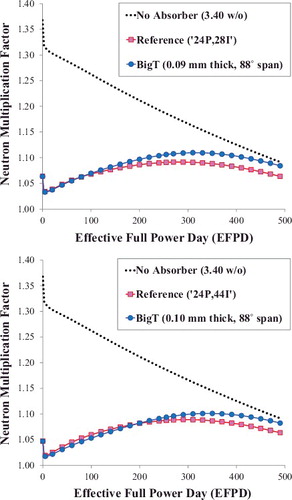
The BigT-AHR design in this section can easily be replaced with the much simpler BigT-fAHR since any replacement of the BigTs in the next cycle is not considered in the current work. Nevertheless, BigT-AHR was modeled in this work since it is more stringent in term of the control rod worth. As shown in , the radius of control absorber is only 0.323 cm in the BigT-loaded core, which can be as thick as 0.371 cm in the BigT-fAHR case. For a consistent comparison against the IFBA and pyrex technologies using boron-10 (B-10) as the BA material, only B4C-based BigT designs are considered in this work. Note that BigT of 88˚ azimuthal span is chosen instead of a homogenous ring design (i.e., 90˚ azimuthal span) since it was previously discovered that a BigT ring with little opening yields a smaller residual reactivity penalty at EOC (end-of-cycle) than that of a fully-closed ring [Citation3].
Results in clearly indicate that the BigT-loaded fuel assemblies can be quite similar to the original fuel assembly designs in terms of the reactivity depletion behavior, when the initial reactivity hold-down is rather similar. It is important to note that the residual reactivity penalty is noticeably smaller in the BigT designs than in the conventional BA concepts when the initial reactivity suppression is relatively large. This observation naturally leads to an expectation that the BigT-loaded AP1000 core will have a longer cycle length.
3.2. Monte Carlo analysis of the 3D AP1000 first core
The 3-D AP1000 initial cores were modeled in quarter-core symmetry, with 12 axial stacks that include two axial layers of fuel blankets and absorber cutbacks. Top and bottom of the core were each capped with two layers of homogenized reflectors. The Serpent-generated models are depicted in . In this preliminary neutronic study on the BigT application to an AP1000 initial core, it is assumed that the fuel and coolant temperatures are constant at 900 and 575 K, respectively, throughout the depletion calculations. As such, multi-physics coupling was not considered in this work partly due to the current computational capability limitation in the available parallel computer and Monte Carlo Serpent code [Citation7]. In addition, concentration of fission product xenon-135 was assumed to be an equilibrium value during the burnup calculations. This option was chosen in order to assure depletion calculational stability in the axial power distributions of the simulated reactors. The two Monte Carlo models, of reference and BigT-loaded AP1000 first cores, were each simulated with 1,000,000 particles per cycle for 500 active and 100 inactive cycles on a Linux cluster computer. The resulting standard deviations of the effective neutron multiplication factors are less than 6 pcm.
Figure 5. Top view (top) and side view (bottom) of the high-fidelity Monte Carlo simulation AP1000 core model.
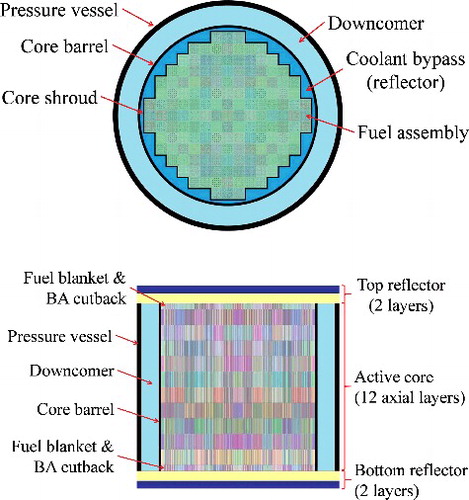
shows reactivity depletions of the simulated reference and BigT-loaded AP1000 first cores throughout the 490-EFPD (effective full power days) cycle, which corresponds to ∼19.4 MWd/kgU burnup. One notes that the initial excess reactivities are clearly very similar (∼9000 pcm) as designed for the two cores. Since both cores utilize B-10 as the chief BA materials, their reactivity depletion patterns are characteristically linear with smooth reactivity gradients. Their reactivity depletion rates are, nonetheless, different as the BigT absorbers burn a little faster due to its smaller BA spatial self-shielding and, consequently, more BA depletions. This results in EOC residual reactivity of ∼1000 pcm at 490 EFPDs for the BigT design. On the other hand, the B4C is strongly lumped in the pyrex rod design in the reference core. As such, the BA is rather highly self-shielded. The simulated reference design, consequently, reaches sub-criticality at about 400 EFPDs (∼15.8 MWd/kgU), substantially earlier than the discharge burnup of ∼21 MWd/kgU documented in CitationRef. [4]. This significant discrepancy between the simulated value and the Westinghouse published data is ascribed to the differences in the modeling and calculation tools (i.e., deterministic versus Monte Carlo, and the absence of multi-physics coupling in this study).
compares the radial assembly-wise power peaking factors against burnup in the AP1000 first core designs. The plots are clearly quite similar, with peaking factors ranging reasonably between 1.2 and 1.5. depicts normalized assembly power distributions at three different burnups. They were again apparently quite comparable, with peaks at BOC (beginning of cycle) ∼1.52. depicts normalized BOC pin power profile of the hottest assembly located at center of the core, with pin peaking factors clearly smaller than 1.13. Note that statistical uncertainties of the normalized radial assembly and pin peaking factors are less than 0.2% and 0.8%, respectively.
Figure 8. Normalized assembly power of 1/8th reference (top) and BigT-loaded (bottom) AP1000 first cores.

shows the axial power peaking factors against burnup in the two AP1000 first cores. It is clear that the axial peaking factors of the BigT-loaded design are similarly low <1.4 as in the reference core throughout the simulated cycle. illustrates the normalized axial power profiles of the two initial cores at different burnups. Both designs show similarly chopped-cosine profiles at BOC due to the flat temperature variation across the core. At MOC (middle of cycle), both cores show saddle-type or saddle-like axial power profiles, while the reference core experiences a little more saddle-like shape. At EOC, edges of the saddle-profiles become more pronounced, and it is noted that the BigT-loaded core displays noticeably higher and sharper peaks. Discrepancy between the reference and BigT designs is progressively noticeable with burnup due to the slightly less self-shielded BA in the BigT-loaded core. Note that statistical uncertainties of the normalized axial peaking factors are reasonably low, less than 0.2%.
Figure 11. Normalized axial power distributions along active height at 0 (top), 255 (middle) and 490 (bottom) EFPDs.
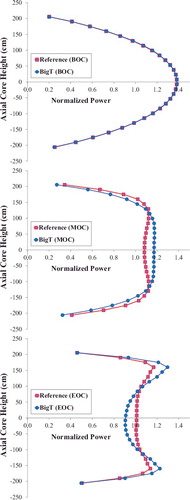
As shown in , 20 control assemblies are BigT-loaded and it is thus expected that the total control rod worth will be smaller in the BigT-loaded core than in the reference core. tabulates the estimated shutdown margins at BOC of the AP1000 first core designs. It should be noted that the EOC shutdown margin of the BigT core will be closer to that of the reference since BigT does not reduce the control rod worth anymore at EOC. The shutdown margin was evaluated conservatively by adopting the method and rod worth requirements documented in CitationRef. [4]. The available control rod worth was re-evaluated for the two cores using Serpent simulations. From , it is clear that a sufficiently high BOC shutdown margin can still be obtained even with the smaller metallic absorber radius of 0.323 cm in the BigT-loaded design. For the Ag–In–Cd absorber in the BigT-loaded core, the total control rod worth is reduced by about 3000 pcm, while its N-1 worth is reduced by only about 1800 pcm. This is because the stuck rod worth is also smaller in the BigT-loaded case. As shown in , the shutdown margin can be enhanced, if necessary, by replacing the Ag–In–Cd with B4C. The shutdown margin can be improved even further by selectively enriching B-10 in the B4C absorber. In , statistical uncertainties of the estimated shutdown margins by Serpent are less than 13 pcm.
Table 3. BOC shutdown margin estimations of the AP1000 first cores.
4. Conclusions
In pursuit of continuous advancement in modern PWR core designs, a novel BA concept named “Burnable absorber-Integrated Guide Thimble” (BigT) was recently proposed. In this work, one potential applications of the BigT absorbers in 3D commercial PWR designs is discussed, namely in an AP1000 initial core. This study clearly demonstrates viability of the BigT absorbers to perform as well as the commercial BA (i.e., pyrex and IFBA) technologies in managing reactivity and power distribution of a model AP1000 initial core. This is because all simulated core neutronic parameters are relatively comparable, specifically in terms of reactivity management, power peaking factors and shutdown margin. In particular, it has been shown that a sufficiently high shutdown margin can be achieved in a BigT-loaded AP1000 initial core. While results of the study clearly demonstrate capability of the BigT concept in a 3D commercial PWR configuration, combination of the state-of-the-art BA technologies with the BigT is also technically feasible. This is especially advantageous for a PWR core requiring a heavy loading of the BA. The combined application of commercial BAs with the BigT should be a valuable future work in the research.
| Nomenclature | ||
| AHR: | = | azimuthally heterogeneous ring |
| BA: | = | burnable absorber |
| BigT: | = | burnable absorber-integrated guide thimble |
| BOC: | = | beginning of cycle |
| BWR: | = | boiling water reactor |
| EFPD: | = | effective full power day |
| EOC: | = | end of cycle |
| fAHR: | = | fixed azimuthally heterogeneous ring |
| HFP: | = | hot full power |
| HZP: | = | hot zero power |
| IFBA: | = | integral fuel burnable absorber |
| LWR: | = | light water reactor |
| MOC: | = | middle of cycle |
| MTC: | = | moderator temperature coefficient |
| PWR: | = | pressurized water reactor |
| US NRC: | = | United States Nuclear Regulatory Commission |
BigT_II_-_05_Appendices__Online_Supplementary_Materials__v2.pdf
Download PDF (1.2 MB)Acknowledgements
This work was supported by the Nuclear Power Core Technology Development Program of the Korea Institute of Energy Technology Evaluation and Planning (KETEP), granted financial resource from the Ministry of Trade, Industry & Energy, Republic of Korea (20131610101850).
Supplemental data for this article can be accessed here.
Disclosure statement
No potential conflict of interest was reported by the authors.
Additional information
Funding
References
- Cacuci DG, editor. Handbook of nuclear engineering. New York, NY: Springer; 2010. p. 1556.
- Secker JR, Brown JA. Westinghouse PWR burnable absorber evolution and usage. Trans Am Nucl Soc. 2010 Nov;103:733–734.
- Yahya MS, Yu HY, Kim Y. Burnable absorber-integrated guide thimble (BigT) – I: design concept and neutronic characterization on the fuel assembly benchmarks. J Nucl Sci Tech. 2015. Available from: http://dx.doi.org/10.1080/00223131.2015.1090937
- Public version of AP1000 design control document revision 19. Pittsburgh, PA: Westinghouse Electric Company LLC; 2011. (Report no. APP-GW-GL-702).
- Ames II DE. Nuclear fuel cycle system simulation tool based on high-fidelity component modeling. Albuquerque, NM: Sandia National Laboratories; 2014. (Report no. SAND2014-0831).
- AP1000 PWR [ Internet]. Pittsburgh, PA: Westinghouse Electric Company LLC; 2015. AP1000 nuclear power plant; 2015 Sep 10 [ cited 2015 Sep 10]; Available from: http://http://www.westinghousenuclear.com/New-Plants/AP1000-PWR
- Leppänen J. Serpent – a continuous energy Monte Carlo reactor physics burnup calculation code. Espoo, Finland: VTT Technical Research Centre of Finland; 2013.

